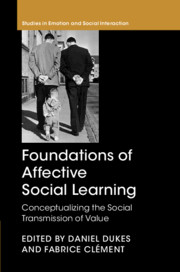Book contents
- Foundations of Affective Social Learning
- Studies in Emotion and Social Interaction
- Foundations of Affective Social Learning
- Copyright page
- Dedication
- Contents
- Figures
- Contributors
- Preface
- A difficult introduction to affective social learning
- Part I On the evolutionary foundations of affective social learning processes
- Part II On human development and affective social learning
- Chapter 3 Affective social learning
- Chapter 4 Natural pedagogy of social emotions
- Part III On the mechanics of affective social learning
- Part IV Applications of affective social learning
- Conclusion
- Index
- Studies in Emotion and Social Interation
- References
Chapter 4 - Natural pedagogy of social emotions
from Part II - On human development and affective social learning
Published online by Cambridge University Press: 09 August 2019
- Foundations of Affective Social Learning
- Studies in Emotion and Social Interaction
- Foundations of Affective Social Learning
- Copyright page
- Dedication
- Contents
- Figures
- Contributors
- Preface
- A difficult introduction to affective social learning
- Part I On the evolutionary foundations of affective social learning processes
- Part II On human development and affective social learning
- Chapter 3 Affective social learning
- Chapter 4 Natural pedagogy of social emotions
- Part III On the mechanics of affective social learning
- Part IV Applications of affective social learning
- Conclusion
- Index
- Studies in Emotion and Social Interation
- References
Summary
This chapter proposes that during human evolution emotion-based social learning systems and the capacity for ostensive communication have become integrated to serve affective social learning and cultural knowledge transmission during ontogenetic development. Human infants communicate and learn by emotions as well as about emotions through ostensive communication and natural pedagogy even before acquiring language. We will argue that the human species’ unique cognitive adaptations for ostensive communication and natural pedagogy provide specialized social learning mechanisms for the acquisition of culturally shared representations of social emotion concepts. We will explore how ostensive emotion-reflective interactions through the mechanism of social bio-feedback also play a central role in the development of introspective sensitivity in infants for detecting and representing their own categorical emotion states and establishing their emerging capacity for emotional self-attribution and affective self-control. Based on this account, we will propose an evolutionary-based view of social emotions as special types of dispositional kind concepts that belong to the ontological kind categories humans share with other social agents in their cultural community. This theory implies a view of dispositional essentialism about representing categorical emotion kinds in humans, which will be contrasted with current versions of biological essentialism exemplified by recent approaches to basic emotions such as differential emotions theory.
Keywords
- Type
- Chapter
- Information
- Foundations of Affective Social LearningConceptualizing the Social Transmission of Value, pp. 87 - 114Publisher: Cambridge University PressPrint publication year: 2019
References
- 4
- Cited by

